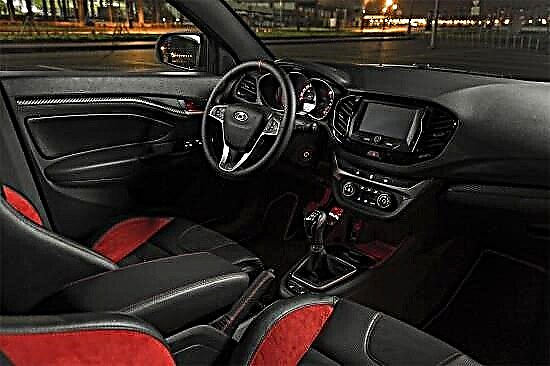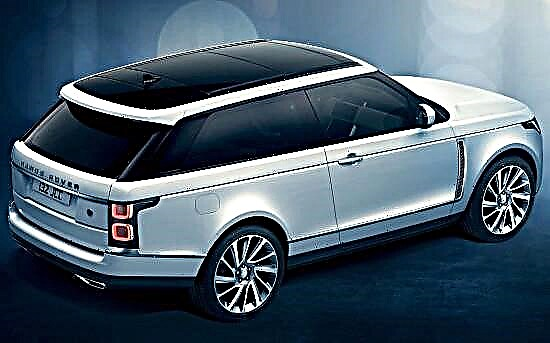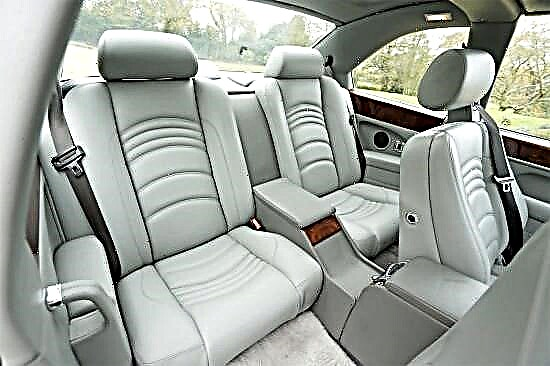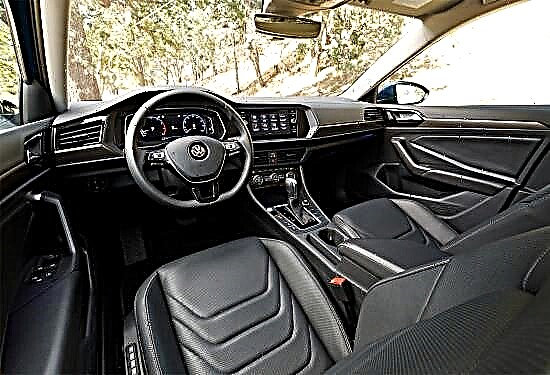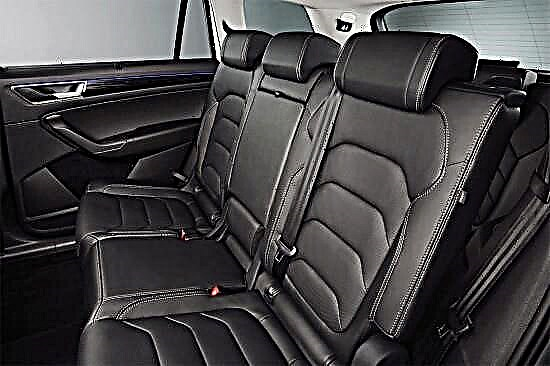The car, named after one of the species of brown bears, took its place one step above the Yeti, making itself known with its striking appearance and large interior space, and also received five variants of turbocharged engines.
The Czech car manufacturer Skoda held a preliminary presentation of the mid-size off-road vehicle “Kodiaq” on September 1, 2016 (in Berlin), and its official debut took place in October (at the stands of the International Paris Auto Show).
In Europe, this crossover literally immediately after its debut began "conquering the wallets of motorists", but it only reached Russia in June 2017 (initially these were Czech-assembled cars, but by the spring of 2018 production was launched in Nizhny Novgorod).

The appearance of the Skoda Kodiaq is made based on the concept "Vision S" (demonstrated to the public in March 2016 at the bridegroom in Geneva) - a tightly knocked down car with angular predatory outlines and muscular forms looks fresh, attractive and dynamic.
Among modern crossovers, "Kodiak" will definitely not get lost thanks to interesting design solutions - squinted "two-story" optics, expressive strokes of stampings, "chubby" bumpers, powerful rounded-square wheel arches and acute-angled taillights.

"Kodiak" is a representative of the mid-size class: its length is 4697 mm, height - 1655 mm, width - 1882 mm. Between the wheelsets of the five-door there is a 2791 mm base, and its ground clearance is 194 mm. In the "stowed" state, the car weighs from 1527 to 1761 kg, depending on the version. By default, the off-road vehicle rests on the road with 17-inch wheels, and optionally available "rollers" with dimensions of 18 and 19 inches.

Inside, the Skoda Kodiaq demonstrates a modern and attractive, but more conservative design compared to the exterior, impeccable German ergonomics and high-quality (in some places even close to "premium") finishing materials.
There is simply nothing to reproach the crossover in the cabin for - a multifunctional steering wheel with a raised rim, a laconic instrument panel with an on-board computer display between the dials and a dumbbell front panel with an inclined center console, decorated with a 6.5 to 8-inch color screen and a stylish climate control unit. systems.

By default, the "Kodiak" decoration is five-seater with comfortable front seats with widely spaced side bolsters and adjustments in solid ranges, and a welcoming rear sofa with adjustment in the longitudinal direction.

The riders of the first and second rows of seats are provided with royal space on all fronts, but the optional "gallery" is suitable only for children (adults, even of small stature, will feel constrained).
In terms of trunk volume, "Kodiak" claims to be one of the best in the class: in a seven-seater configuration, 270 liters of luggage fits into the "hold", and in a five-seater one - 720 liters. If you leave only two on board, then the capacity of the cargo compartment of the car increases to a decent 2065 liters, and you get an absolutely flat area.

For Skoda Kodiaq, a wide palette of four-cylinder power plants, well known from other models of the Volkswagen AG concern, has been prepared:
- Less "capable" versions of the SUV are assigned to the 1.4-liter TSI EA211 series petrol engine with a lightweight aluminum cylinder block, a turbocharger, optimized direct injection and a 16-valve timing structure. It is available in two levels of "pumping": 125 horsepower at 5000-6000 rpm and 200 Nm of peak thrust at 1400-4000 rpm or 150 "mares" at 5000-6000 rpm and 250 Nm at 1500-3500 rpm. In the "junior" version, the "four" is combined exclusively with 6-speed "mechanics" and front-wheel drive, and in the "senior" - also with a 6-band "robot" DSG and all-wheel drive transmission. With such "weapons" the crossover accelerates to "hundreds" after 9.4-10.7 seconds, is able to squeeze out 190-198 km / h and "destroys" no more than 6-7.1 liters of fuel in the "highway / city" cycle.
- The head of the petrol range is the 2.0-liter TSI unit with an exhaust manifold integrated into the aluminum cylinder block, combined power supply, turbocharging and phase shifters on two camshafts, generating 180 "stallions" at 3900-6000 rpm and 320 Nm of torque at 1400-3940 rpm minute. In conjunction with a 7-speed DSG and all-wheel drive, it "shoots" the car up to 100 km / h in 7.8 seconds, provides it with 206 km / h peak capabilities and "eats" 7.3 liters of fuel in combined mode.
- Diesel modifications of "Kodiak" are driven by a 2.0-liter TDI engine with a turbocharger, direct power supply to Common Rail and a 16-valve timing belt. Its potential is 150 "horses" at 3500-4000 rpm and 340 Nm of available thrust at 1750-3000 rpm, or 190 horsepower and 400 Nm at similar rpm. In the first case, the diesel engine mates with a 6-speed manual transmission or a 7-band "robot" and front or all-wheel drive, and in the second - exclusively with an "automatic" transmission and four drive wheels. Such a "Czech" is gaining maximum 194-210 km / h, coping with the first "hundred" in 8.6-10 seconds, and consumes from 5 to 5.7 liters of "diesel" in mixed conditions.
The all-wheel drive on the Skoda Kodiaq is implemented according to a typical crossover scheme - the Haldex hydraulic multi-plate clutch of the fifth embodiment with electronic control is responsible for supplying power to the rear axle wheels. Under normal conditions, the front wheels spend 100% of the moment, and depending on the road conditions, the thrust is automatically distributed between the axles. Despite the presence of all-wheel drive versions and quite a decent ground clearance, the off-road capabilities of the car leave much to be desired - for example, the angles of entry and exit, respectively, do not exceed 22 and 23 degrees.
The base for the Skoda Kodiaq is a modular front-wheel drive platform MQB with an independent chassis on both axles: McPherson struts are involved in the front, and a four-link system in the rear (there are transverse stabilizers "in a circle"). In the "maximum" versions, the five-door "flaunts" the adaptive suspension Dynamic Chassis Control with several modes of operation - Normal, Sport and Comfort (the all-wheel drive versions also have an off-road mode). High-strength grades of steel are abundantly used in the body structure of the SUV.
By default, the steering complex of the "Czech" is supplemented with an electric amplifier with progressive characteristics, and its brake complex is formed by disc brakes of four wheels (with front ventilation) and a wide range of electronic "gadgets" (ABS, EBD, BAS and others).
In the Russian market, Skoda Kodiaq in 2018 is offered in three trim levels to choose from - "Active", "Ambition" and "Style":
A basic car with a 125-horsepower engine and "mechanics" costs at least 1,339,000 rubles, a version with a 150-horsepower unit and a "robot" will cost from 1,480,000 rubles, and you can't buy an all-wheel drive version for less than 1,505,000 rubles.
Nominally, the SUV has: four airbags, power windows for all doors, a media center with a touch screen, heated front seats, 17-inch alloy wheels, ABS, ESP, dual-zone "climate", the ERA-GLONASS system, a radio tape recorder with eight speakers and some other modern equipment ...
A crossover in the "Ambition" configuration is sold at a price of 1,512,000 rubles, and for the "top-end" modification you will need to pay at least 1,769,000 rubles.
The most "sophisticated" car "flaunts": nine airbags, combined trim, front and rear parking sensors, keyless engine start, LED headlights, 18-inch "rollers", a rear view camera, a more advanced infotainment system, distance control function and other "bells and whistles".

